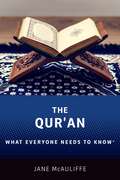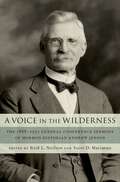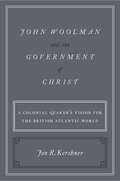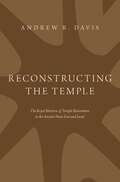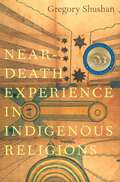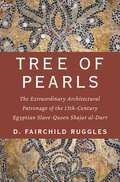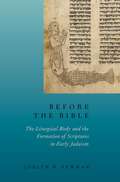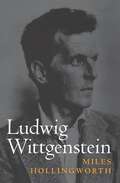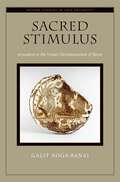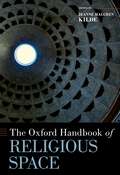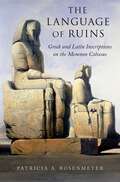- Table View
- List View
QUR'AN WENK C: What Everyone Needs to Know® (What Everyone Needs to Know #6)
by Jane McAuliffeMillions of non-Muslims know the name of the Muslim scripture, whether it is written as "Qur'an" or "Quran" or "Koran." But for most, that is all they know. Many have fallen victim to the mass of misinformation that circulates about the Qur'an. Others may have tried to read the Qur'an, but the text itself is tough to decipher. With no sense of context, chronology, or interpretive history, many would-be readers of the Qur'an quickly give up the effort. As for those trying to find out what the Qur'an says about any particular subject or issue, they, too, soon discover that this is not a simple or straightforward undertaking. A clear, concise introduction to the holy book that guides the lives of 1.6 billion people on our planet, this brief volume opens the world of the Qur'an to interested readers who want to know where this scripture came from and how it has achieved a profound influence in today's world. Writing in an easy-to-read question-and-answer format, Jane McAuliffe, one of the world's foremost scholars of the Qur'an, introduces readers to this important text by discussing its origins, structure, themes, interpretations, and what it has to say about a host of critical contemporary issues. Where did the Qur'an come from? Do Muslims believe that the Qur'an is God's own word? How do Muslims study the Qur'an? What does the Qur'an say about God? About family? About ethics? About violence? By answering the questions that many people have about the Qur'an and its role in Muslim faith, this book offers an invaluable resource for anyone who is curious about one of the world's most important faiths.
A Voice in the Wilderness: The 1888-1930 General Conference Sermons of Mormon Historian Andrew Jenson
In April 1888, Andrew Jenson, Danish immigrant and convert to the Mormon faith, received an unexpected invitation from church leaders to speak at their general conference. Jenson was an outsider to this conference tradition, a layman whose only standing before the main body of Latter-day Saints came from a contracted position with the Church Historian's Office. Forty-two years later, in April 1930, Jenson offered his twenty-eighth and final general conference sermon. He had become the voice of institutional record keeping in his over forty-year career as an Assistant Church Historian. His sermons demonstrated the growth and expansion of the Mormon general conference tradition in the twentieth century, as they placed the Latter-day Saint story front and center for church members to learn from and celebrate. In addition, Jenson urged conference goers to keep better personal and institutional records and believed he was often the solitary advocate for church record keeping and historical preservation. A Voice in the Wilderness presents all twenty-eight of Andrew Jenson's general conference sermons, with introductions and annotations that set them within their historical and religious contexts. His speeches capture a unique period in Mormon history, one of institutional change, accommodation, and growth. This study of Jenson's sermons uncovers the richness and diversity that thrives just beneath the surface of official ecclesiastical discourse.
A Voice in the Wilderness: The 1888-1930 General Conference Sermons of Mormon Historian Andrew Jenson
by Reid L. Neilson and Scott D. MariannoIn April 1888, Andrew Jenson, Danish immigrant and convert to the Mormon faith, received an unexpected invitation from church leaders to speak at their general conference. Jenson was an outsider to this conference tradition, a layman whose only standing before the main body of Latter-day Saints came from a contracted position with the Church Historian's Office. Forty-two years later, in April 1930, Jenson offered his twenty-eighth and final general conference sermon. He had become the voice of institutional record keeping in his over forty-year career as an Assistant Church Historian. His sermons demonstrated the growth and expansion of the Mormon general conference tradition in the twentieth century, as they placed the Latter-day Saint story front and center for church members to learn from and celebrate. In addition, Jenson urged conference goers to keep better personal and institutional records and believed he was often the solitary advocate for church record keeping and historical preservation. A Voice in the Wilderness presents all twenty-eight of Andrew Jenson's general conference sermons, with introductions and annotations that set them within their historical and religious contexts. His speeches capture a unique period in Mormon history, one of institutional change, accommodation, and growth. This study of Jenson's sermons uncovers the richness and diversity that thrives just beneath the surface of official ecclesiastical discourse.
John Woolman and the Government of Christ: A Colonial Quaker's Vision for the British Atlantic World
by Jon R. KershnerIn 1758, a Quaker tailor and sometime shopkeeper and school teacher stood up in a Quaker meeting and declared that the time had come for Friends to reject the practice of slavery. That man was John Woolman, and that moment was a significant step, among many, toward the abolition of slavery in the United States. Woolman's antislavery position was only one essential piece of his comprehensive theological vision for colonial American society. Drawing on Woolman's entire body of writing, Jon R. Kershner reveals that the theological and spiritual underpinnings of Woolman's alternative vision for the British Atlantic world were nothing less than a direct, spiritual christocracy on earth, what Woolman referred to as "the Government of Christ." Kershner argues that Woolman's theology is best understood as apocalyptic-centered on a supernatural revelation of Christ's immediate presence governing all aspects of human affairs, and envisaging the impending victory of God's reign over apostasy. John Woolman and the Government of Christ explores the theological reasoning behind Woolman's critique of the burgeoning trans-Atlantic economy, slavery, and British imperial conflicts, and fundamentally reinterprets 18th-century Quakerism by demonstrating the continuing influence of early Quaker apocalypticism.
John Woolman and the Government of Christ: A Colonial Quaker's Vision for the British Atlantic World
by Jon R. KershnerIn 1758, a Quaker tailor and sometime shopkeeper and school teacher stood up in a Quaker meeting and declared that the time had come for Friends to reject the practice of slavery. That man was John Woolman, and that moment was a significant step, among many, toward the abolition of slavery in the United States. Woolman's antislavery position was only one essential piece of his comprehensive theological vision for colonial American society. Drawing on Woolman's entire body of writing, Jon R. Kershner reveals that the theological and spiritual underpinnings of Woolman's alternative vision for the British Atlantic world were nothing less than a direct, spiritual christocracy on earth, what Woolman referred to as "the Government of Christ." Kershner argues that Woolman's theology is best understood as apocalyptic-centered on a supernatural revelation of Christ's immediate presence governing all aspects of human affairs, and envisaging the impending victory of God's reign over apostasy. John Woolman and the Government of Christ explores the theological reasoning behind Woolman's critique of the burgeoning trans-Atlantic economy, slavery, and British imperial conflicts, and fundamentally reinterprets 18th-century Quakerism by demonstrating the continuing influence of early Quaker apocalypticism.
Infinite Paths to Infinite Reality: Sri Ramakrishna and Cross-Cultural Philosophy of Religion
by Ayon MaharajSri Ramakrishna is widely known as a nineteenth-century Indian mystic who affirmed the harmony of all religions on the basis of his richly varied spiritual experiences and eclectic religious practices, both Hindu and non-Hindu. In Infinite Paths to Infinite Reality, Ayon Maharaj argues that Sri Ramakrishna was also a sophisticated philosopher of great contemporary relevance. Through a careful study of Sri Ramakrishna's recorded oral teachings in the original Bengali, Maharaj reconstructs his philosophical positions and analyzes them from a cross-cultural perspective. Sri Ramakrishna's spiritual journey culminated in the exalted state of "vijñana," his term for the "intimate knowledge" of God as the Infinite Reality that is both personal and impersonal, with and without form, immanent in the universe and beyond it. This expansive spiritual standpoint of vijñana, Maharaj contends, opens up a new paradigm for addressing central issues in cross-cultural philosophy of religion, including divine infinitude, religious pluralism, mystical experience, and the problem of evil. Sri Ramakrishna's vijñana-based religious pluralism--when grasped in all its subtlety--proves to have major philosophical advantages over dominant Western models. Moreover, his mystical testimony and teachings not only cut across long-standing debates about the nature of mystical experience but also bolster recent defenses of its epistemic value. Maharaj further demonstrates that Sri Ramakrishna's unique response to the problem of evil resonates strongly with Western "soul-making" theodicies and contemporary theories of skeptical theism. A pioneering interdisciplinary study of one of India's most important philosopher-mystics, Maharaj's book is essential reading for scholars and students in philosophy of religion, theology, religious studies, and Hindu studies.
Infinite Paths to Infinite Reality: Sri Ramakrishna and Cross-Cultural Philosophy of Religion
by Ayon MaharajSri Ramakrishna is widely known as a nineteenth-century Indian mystic who affirmed the harmony of all religions on the basis of his richly varied spiritual experiences and eclectic religious practices, both Hindu and non-Hindu. In Infinite Paths to Infinite Reality, Ayon Maharaj argues that Sri Ramakrishna was also a sophisticated philosopher of great contemporary relevance. Through a careful study of Sri Ramakrishna's recorded oral teachings in the original Bengali, Maharaj reconstructs his philosophical positions and analyzes them from a cross-cultural perspective. Sri Ramakrishna's spiritual journey culminated in the exalted state of "vijñana," his term for the "intimate knowledge" of God as the Infinite Reality that is both personal and impersonal, with and without form, immanent in the universe and beyond it. This expansive spiritual standpoint of vijñana, Maharaj contends, opens up a new paradigm for addressing central issues in cross-cultural philosophy of religion, including divine infinitude, religious pluralism, mystical experience, and the problem of evil. Sri Ramakrishna's vijñana-based religious pluralism--when grasped in all its subtlety--proves to have major philosophical advantages over dominant Western models. Moreover, his mystical testimony and teachings not only cut across long-standing debates about the nature of mystical experience but also bolster recent defenses of its epistemic value. Maharaj further demonstrates that Sri Ramakrishna's unique response to the problem of evil resonates strongly with Western "soul-making" theodicies and contemporary theories of skeptical theism. A pioneering interdisciplinary study of one of India's most important philosopher-mystics, Maharaj's book is essential reading for scholars and students in philosophy of religion, theology, religious studies, and Hindu studies.
Reconstructing the Temple: The Royal Rhetoric of Temple Renovation in the Ancient Near East and Israel
by Andrew R. DavisThis book examines temple renovation as a rhetorical topic within royal literature of the ancient Near East. Unlike newly founded temples, which were celebrated for their novelty, temple renovations were oriented toward the past. Kings took the opportunity to rehearse a selective history of the temple, evoking certain past traditions and omitting others. In this way, temple renovations were a kind of historiography. Andrew R. Davis demonstrates a pattern in the rhetoric of temple renovation texts: that kings in ancient Mesopotamia, Israel, Syria and Persia used temple renovation to correct, or at least distance themselves from, some turmoil of recent history and to associate their reigns with an earlier and more illustrious past. Davis draws on the royal literature of the seventh and sixth centuries BCE for main evidence of this rhetoric. Furthermore, he argues for reading the story of Jeroboam I's placement of calves at Dan and Bethel (1 Kgs 12:25-33) as an eighth-century BCE account of temple renovation with a similar rhetoric. Concluding with further examples in the Hellenistic and Roman periods, Reconstructing the Temple demonstrates that the rhetoric of temple renovation was a distinct and longstanding topic in the ancient Near East.
RECONSTRUCTING THE TEMPLE C: The Royal Rhetoric of Temple Renovation in the Ancient Near East and Israel
by Andrew R. DavisThis book examines temple renovation as a rhetorical topic within royal literature of the ancient Near East. Unlike newly founded temples, which were celebrated for their novelty, temple renovations were oriented toward the past. Kings took the opportunity to rehearse a selective history of the temple, evoking certain past traditions and omitting others. In this way, temple renovations were a kind of historiography. Andrew R. Davis demonstrates a pattern in the rhetoric of temple renovation texts: that kings in ancient Mesopotamia, Israel, Syria and Persia used temple renovation to correct, or at least distance themselves from, some turmoil of recent history and to associate their reigns with an earlier and more illustrious past. Davis draws on the royal literature of the seventh and sixth centuries BCE for main evidence of this rhetoric. Furthermore, he argues for reading the story of Jeroboam I's placement of calves at Dan and Bethel (1 Kgs 12:25-33) as an eighth-century BCE account of temple renovation with a similar rhetoric. Concluding with further examples in the Hellenistic and Roman periods, Reconstructing the Temple demonstrates that the rhetoric of temple renovation was a distinct and longstanding topic in the ancient Near East.
Victorian Muslim: Abdullah Quilliam and Islam in the West
After formally announcing his conversion to Islam in the late 1880s, the Liverpool lawyer William Henry Abdullah Quilliam publicly propagated his new faith and established the first community of Muslim converts in Victorian Britain. Despite decades of relative obscurity following his death, with the resurgence of interest in Muslim heritage in the West since 9/11 Quilliam has achieved iconic status in Britain and beyond as a pivotal figure in the history of Western Islam and Muslim-Christian relations. In this timely book, leading experts of the religion, history and politics of Islam offer new perspectives and shed fresh light on Quilliam's life and work. Through a series of original essays, the authors critically examine Quilliam's influences, philosophy and outlook, the significance of his work for Islam, his position in the Muslim world and his legacy. Collectively, the authors ask pertinent questions about how conversion to Islam was viewed and received historically, and how a zealous convert like Quilliam negotiated his religious and national identities and sought to indigenise Islam in a non-Muslim country.
Victorian Muslim: Abdullah Quilliam and Islam in the West
by Jamie Gilham & Ron GeavesAfter formally announcing his conversion to Islam in the late 1880s, the Liverpool lawyer William Henry Abdullah Quilliam publicly propagated his new faith and established the first community of Muslim converts in Victorian Britain. Despite decades of relative obscurity following his death, with the resurgence of interest in Muslim heritage in the West since 9/11 Quilliam has achieved iconic status in Britain and beyond as a pivotal figure in the history of Western Islam and Muslim-Christian relations. In this timely book, leading experts of the religion, history and politics of Islam offer new perspectives and shed fresh light on Quilliam's life and work. Through a series of original essays, the authors critically examine Quilliam's influences, philosophy and outlook, the significance of his work for Islam, his position in the Muslim world and his legacy. Collectively, the authors ask pertinent questions about how conversion to Islam was viewed and received historically, and how a zealous convert like Quilliam negotiated his religious and national identities and sought to indigenise Islam in a non-Muslim country.
Near-Death Experience in Indigenous Religions
by Gregory ShushanNear-death experiences are known around the world and throughout human history. They are sometimes reported by individuals who have revived from a period of clinical death or near-death and they typically feature sensations of leaving the body, entering and emerging from darkness, meeting deceased friends and relatives, encountering beings of light, judgment of one's earthly life, feelings of oneness, and reaching barriers, only to return to the body. Those who have NDEs almost invariably understand them as having profound spiritual or religious significance. In this book, Gregory Shushan explores the relationship between NDEs, shamanism, and beliefs about the afterlife in traditional indigenous societies in Africa, North America, and Oceania. Drawing on historical accounts of the earliest encounters with explorers, missionaries, and ethnologists, this study addresses questions such as: Do ideas about the afterlife commonly originate in NDEs? What role does culture play in how people experience and interpret NDEs? How can we account for cross-cultural similarities and differences between afterlife beliefs? Though NDEs are universal, Shushan shows that how they are actually experienced and interpreted varies by region and culture. In North America, they were commonly valorized, and attempts were made to replicate them through shamanic rituals. In Africa, however, they were largely considered aberrational events with links to possession or sorcery. In Oceania, Micronesia corresponded more to the African model, while Australia had a greater focus on afterlife journey shamanism, and Polynesia and Melanesia showed an almost casual acceptance of the phenomenon as reflected in numerous myths, legends, and historical accounts. This study examines the continuum of similarities and differences between NDEs, shamanism, and afterlife beliefs in dozens of cultures throughout these regions. In the process, it makes a valuable contribution to our knowledge about the origins of afterlife beliefs around the world and the significance of related experiences in human history.
Near-Death Experience in Indigenous Religions
by Gregory ShushanNear-death experiences are known around the world and throughout human history. They are sometimes reported by individuals who have revived from a period of clinical death or near-death and they typically feature sensations of leaving the body, entering and emerging from darkness, meeting deceased friends and relatives, encountering beings of light, judgment of one's earthly life, feelings of oneness, and reaching barriers, only to return to the body. Those who have NDEs almost invariably understand them as having profound spiritual or religious significance. In this book, Gregory Shushan explores the relationship between NDEs, shamanism, and beliefs about the afterlife in traditional indigenous societies in Africa, North America, and Oceania. Drawing on historical accounts of the earliest encounters with explorers, missionaries, and ethnologists, this study addresses questions such as: Do ideas about the afterlife commonly originate in NDEs? What role does culture play in how people experience and interpret NDEs? How can we account for cross-cultural similarities and differences between afterlife beliefs? Though NDEs are universal, Shushan shows that how they are actually experienced and interpreted varies by region and culture. In North America, they were commonly valorized, and attempts were made to replicate them through shamanic rituals. In Africa, however, they were largely considered aberrational events with links to possession or sorcery. In Oceania, Micronesia corresponded more to the African model, while Australia had a greater focus on afterlife journey shamanism, and Polynesia and Melanesia showed an almost casual acceptance of the phenomenon as reflected in numerous myths, legends, and historical accounts. This study examines the continuum of similarities and differences between NDEs, shamanism, and afterlife beliefs in dozens of cultures throughout these regions. In the process, it makes a valuable contribution to our knowledge about the origins of afterlife beliefs around the world and the significance of related experiences in human history.
Tree of Pearls: The Extraordinary Architectural Patronage of the 13th-Century Egyptian Slave-Queen Shajar al-Durr
by D. Fairchild RugglesShajar al-Durr--known as "Tree of Pearls"--began her remarkable career as a child slave, given as property to the Ayyubid Sultan Salih of Egypt. She became his favorite concubine, was manumitted, became the sultan's wife, served as governing regent, and ultimately rose to become the legitimately appointed sultan of Egypt in 1250 after her husband's death. Shajar al-Durr used her wealth and power to add a tomb to his urban madrasa; with this innovation, madrasas and many other charitably endowed architectural complexes became commemorative monuments, a practice that remains widespread today. A highly unusual case of a Muslim woman authorized to rule in her own name, her reign ended after only three months when she was forced to share her governance with an army general from the ranks of the Mamluks (elite slave soldiers) and for political expediency to marry him. Despite the fact that Shajar al-Durr's story ends tragically with her assassination and hasty burial, her deeds in her lifetime offer a stark alternative to the continued belief that women in the medieval period were unseen, anonymous, and inconsequential in a world that belonged to men. This biography--the first ever in English--will place the rise and fall of the sultan-queen in the wider context of the cultural and architectural development of Cairo, the city that still holds one of the largest and most important collections of Islamic monuments in the world. D. Fairchild Ruggles also situates the queen's extraordinary architectural patronage in relation to other women of her own time, such as Aleppo's Ayyubid regent. Tree of Pearls concludes with a lively discussion of what we can know about the material impact of women of both high and lesser social rank in this period, and why their impact matters in the writing of history.
Tree of Pearls: The Extraordinary Architectural Patronage of the 13th-Century Egyptian Slave-Queen Shajar al-Durr
by D. Fairchild RugglesShajar al-Durr--known as "Tree of Pearls"--began her remarkable career as a child slave, given as property to the Ayyubid Sultan Salih of Egypt. She became his favorite concubine, was manumitted, became the sultan's wife, served as governing regent, and ultimately rose to become the legitimately appointed sultan of Egypt in 1250 after her husband's death. Shajar al-Durr used her wealth and power to add a tomb to his urban madrasa; with this innovation, madrasas and many other charitably endowed architectural complexes became commemorative monuments, a practice that remains widespread today. A highly unusual case of a Muslim woman authorized to rule in her own name, her reign ended after only three months when she was forced to share her governance with an army general from the ranks of the Mamluks (elite slave soldiers) and for political expediency to marry him. Despite the fact that Shajar al-Durr's story ends tragically with her assassination and hasty burial, her deeds in her lifetime offer a stark alternative to the continued belief that women in the medieval period were unseen, anonymous, and inconsequential in a world that belonged to men. This biography--the first ever in English--will place the rise and fall of the sultan-queen in the wider context of the cultural and architectural development of Cairo, the city that still holds one of the largest and most important collections of Islamic monuments in the world. D. Fairchild Ruggles also situates the queen's extraordinary architectural patronage in relation to other women of her own time, such as Aleppo's Ayyubid regent. Tree of Pearls concludes with a lively discussion of what we can know about the material impact of women of both high and lesser social rank in this period, and why their impact matters in the writing of history.
Before the Bible: The Liturgical Body and the Formation of Scriptures in early Judaism
by Judith H. NewmanBefore the Bible reveals the landscape of scripture in an era prior to the crystallization of the rabbinic Bible and the canonization of the Christian Bible. Most accounts of the formation of the Hebrew Bible trace the origins of scripture through source critical excavation of the archaeological "tel" of the Bible or the analysis of the scribal hand on manuscripts in text-critical work, but the discoveries in the Dead Sea Scrolls have transformed our understanding of scripture formation. Judith Newman focuses not on the putative origins and closure of the Bible, but on the reasons why scriptures remained open, with pluriform growth in the Hellenistic-Roman period. Drawing on new methods from cognitive neuroscience and the social sciences as well as traditional philological and literary analysis, Before the Bible argues that the key to understanding the formation of scripture is the widespread practice of individual and communal prayer in early Judaism. The figure of the teacher as a learned and pious sage capable of interpreting and embodying the tradition is central to understanding this revelatory phenomenon. The book considers the entwinement of prayer and scriptural formation in five books reflecting the diversity of early Judaism: Ben Sira, Daniel, Jeremiah/Baruch, Second Corinthians, and the Qumran Hodayot (Thanksgiving Hymns). While not a complete taxonomy of scripture formation, the book illuminates performative dynamics that have been largely ignored as well as the generative role of interpretive tradition in accounts of how the Bible came to be.
Ludwig Wittgenstein
by Miles HollingworthAfter his intellectual biography, Saint Augustine of Hippo, Miles Hollingworth now turns his attention to one of Augustine's greatest modern admirers: The Austrian philosopher Ludwig Wittgenstein. Wittgenstein's influence on post-war philosophical investigation has been pervasive, while his eccentric life has entered folklore. Yet his religious mysticism has remained elusive and undisturbed. In Ludwig Wittgenstein, Hollingworth continues to pioneer a new kind of biographical writing. It stands at the intersection of philosophy, theology and literary criticism, and is as much concerned with the secret agendas of life writing as it is with its Subjects. Here, Wittgenstein is allowed to become the ultimate test case. From first to last, his philosophy sought to demonstrate that intellectual certainty is a function of the method it employs, rather than a knowledge of the existence or non-existence of its objects--a devastating insight that appears to make the natural and the supernatural into equally useless examples of each other. This biography proceeds in the same way. Scattered in every direction by this challenge to meaning, it attempts to retrieve itself around the spirit of the man who could say such things. This act of recovery thus performs what could not otherwise be explained, which is something like Wittgenstein's private conversation with God.
Ludwig Wittgenstein
by Miles HollingworthAfter his intellectual biography, Saint Augustine of Hippo, Miles Hollingworth now turns his attention to one of Augustine's greatest modern admirers: The Austrian philosopher Ludwig Wittgenstein. Wittgenstein's influence on post-war philosophical investigation has been pervasive, while his eccentric life has entered folklore. Yet his religious mysticism has remained elusive and undisturbed. In Ludwig Wittgenstein, Hollingworth continues to pioneer a new kind of biographical writing. It stands at the intersection of philosophy, theology and literary criticism, and is as much concerned with the secret agendas of life writing as it is with its Subjects. Here, Wittgenstein is allowed to become the ultimate test case. From first to last, his philosophy sought to demonstrate that intellectual certainty is a function of the method it employs, rather than a knowledge of the existence or non-existence of its objects--a devastating insight that appears to make the natural and the supernatural into equally useless examples of each other. This biography proceeds in the same way. Scattered in every direction by this challenge to meaning, it attempts to retrieve itself around the spirit of the man who could say such things. This act of recovery thus performs what could not otherwise be explained, which is something like Wittgenstein's private conversation with God.
After Arminius: A Historical Introduction to Arminian Theology
by Thomas H. McCall Keith D. StanglinInspired by the ideas of the Dutch theologian Jacob Arminius, Arminianism was the subject of important theological controversies in the seventeenth and eighteenth centuries, and still today remains an important position within Protestant thought. What became known as Arminian theology was held by people across a wide swath of geographical and ecclesial positions. This theological movement was in part a reaction to the Reformed doctrine of predestination and was founded on the assertion that God's sovereignty and human free will are compatible. More broadly, it was an attempt to articulate a holistic view of God and salvation that is grounded in Scripture and Christian tradition as well as adequate to the challenges of life. First developed in European, British, and American contexts, the movement engaged with a wide range of intellectual challenges. While standing together in their common rejection of several key planks of Reformed theology, supporters of Arminianism took varying positions on other matters. Some were broadly committed to catholic and creedal theology, while others were more open to theological revision. Some were concerned primarily with practical matters, while others were engaged in system-building as they sought to articulate and defend an over-arching vision of God and the world. The story of Arminian development is complex, yet essential for a proper understanding of the history of Protestant theology. The historical development of Arminian theology, however, is not well known. In After Arminius, Thomas H. McCall and Keith D. Stanglin offer a thorough historical introduction to Arminian theology, providing an account that will be useful to scholars and students of ecclesiastical history and modern Christian thought.
After Arminius: A Historical Introduction to Arminian Theology
by Thomas H. McCall Keith D. StanglinInspired by the ideas of the Dutch theologian Jacob Arminius, Arminianism was the subject of important theological controversies in the seventeenth and eighteenth centuries, and still today remains an important position within Protestant thought. What became known as Arminian theology was held by people across a wide swath of geographical and ecclesial positions. This theological movement was in part a reaction to the Reformed doctrine of predestination and was founded on the assertion that God's sovereignty and human free will are compatible. More broadly, it was an attempt to articulate a holistic view of God and salvation that is grounded in Scripture and Christian tradition as well as adequate to the challenges of life. First developed in European, British, and American contexts, the movement engaged with a wide range of intellectual challenges. While standing together in their common rejection of several key planks of Reformed theology, supporters of Arminianism took varying positions on other matters. Some were broadly committed to catholic and creedal theology, while others were more open to theological revision. Some were concerned primarily with practical matters, while others were engaged in system-building as they sought to articulate and defend an over-arching vision of God and the world. The story of Arminian development is complex, yet essential for a proper understanding of the history of Protestant theology. The historical development of Arminian theology, however, is not well known. In After Arminius, Thomas H. McCall and Keith D. Stanglin offer a thorough historical introduction to Arminian theology, providing an account that will be useful to scholars and students of ecclesiastical history and modern Christian thought.
Sacred Stimulus: Jerusalem in the Visual Christianization of Rome (Oxford Studies in Late Antiquity)
by Galit Noga-BanaiSacred Stimulus offers a thorough exploration of Jerusalem's role in the formation and formulation of Christian art in Rome during the fourth and fifth centuries. The visual vocabulary discussed by Galit Noga-Banai gives an alternative access point to the mnemonic efforts conceived while Rome converted to Christianity: not in comparison to pagan art in Rome, not as reflecting the struggle with the emergence of New Rome in the East (Constantinople), but rather as visual expressions of the confrontation with earthly Jerusalem and its holy places. After all, Jerusalem is where the formative events of Christianity occurred and were memorialized. Sacred Stimulus argues that, already in the second half of the fourth century, Rome constructed its own set of holy sites and foundational myths, while expropriating for its own use some of Jerusalem's sacred relics, legends, and sites. Relying upon well-known and central works of art, including mosaic decoration, sarcophagi, wall paintings, portable art, and architecture, Noga-Banai exposes the omnipresence of Jerusalem and its position in the genesis of Christian art in Rome. Noga-Banai's consideration of earthly Jerusalem as a conception that Rome used, or had to take into account, in constructing its own new Christian ideological and cultural topography of the past, sheds light on connections and analogies that have not necessarily been preserved in the written evidence, and offers solutions to long-standing questions regarding specific motifs and scenes.
Sacred Stimulus: Jerusalem in the Visual Christianization of Rome (Oxford Studies in Late Antiquity)
by Galit Noga-BanaiSacred Stimulus offers a thorough exploration of Jerusalem's role in the formation and formulation of Christian art in Rome during the fourth and fifth centuries. The visual vocabulary discussed by Galit Noga-Banai gives an alternative access point to the mnemonic efforts conceived while Rome converted to Christianity: not in comparison to pagan art in Rome, not as reflecting the struggle with the emergence of New Rome in the East (Constantinople), but rather as visual expressions of the confrontation with earthly Jerusalem and its holy places. After all, Jerusalem is where the formative events of Christianity occurred and were memorialized. Sacred Stimulus argues that, already in the second half of the fourth century, Rome constructed its own set of holy sites and foundational myths, while expropriating for its own use some of Jerusalem's sacred relics, legends, and sites. Relying upon well-known and central works of art, including mosaic decoration, sarcophagi, wall paintings, portable art, and architecture, Noga-Banai exposes the omnipresence of Jerusalem and its position in the genesis of Christian art in Rome. Noga-Banai's consideration of earthly Jerusalem as a conception that Rome used, or had to take into account, in constructing its own new Christian ideological and cultural topography of the past, sheds light on connections and analogies that have not necessarily been preserved in the written evidence, and offers solutions to long-standing questions regarding specific motifs and scenes.
The Oxford Handbook of Religious Space (OXFORD HANDBOOKS SERIES)
by Jeanne Halgren KildeHow do we understand religious spaces? What is their role or function within specific religious traditions or with respect to religious experience? This handbook brings together thirty-three essays addressing these questions using a range of methods and approaches to examine specific spaces or types of spaces around the world and across time. The authors here represent and draw upon many disciplines: religious studies and religion, anthropology, archaeology, architectural history and architecture, cultural and religious history, sociology, geography, gender and women's studies and others. Their essays are snapshots, each offering a specific way to think about the religious space(s) under consideration: Roman shrines, Jewish synagogues, Christian churches, Muslim and Catholic shrines, indigenous spaces in Central America and East Africa, cemeteries, memorials, and more. Some overarching principles emerge from these snapshots. The authors demonstrate that religious spaces are simultaneously individual and collective, personal and social; that they are influenced by culture, tradition, and immediate circumstances; and that they participate in various relationships of power. These essays demonstrate that religious spaces do not simply provide a convenient background for religious action but are also constituent of religious meaning and religious experience; they play an active role in creating, expressing, broadcasting, maintaining, and transforming religious meanings and religious experiences. By learning how religious spaces function, readers of this collection will gain a deeper understanding of religious life and religions themselves.
The Oxford Handbook of Religious Space (OXFORD HANDBOOKS SERIES)
by Jeanne Halgren KildeHow do we understand religious spaces? What is their role or function within specific religious traditions or with respect to religious experience? This handbook brings together thirty-three essays addressing these questions using a range of methods and approaches to examine specific spaces or types of spaces around the world and across time. The authors here represent and draw upon many disciplines: religious studies and religion, anthropology, archaeology, architectural history and architecture, cultural and religious history, sociology, geography, gender and women's studies and others. Their essays are snapshots, each offering a specific way to think about the religious space(s) under consideration: Roman shrines, Jewish synagogues, Christian churches, Muslim and Catholic shrines, indigenous spaces in Central America and East Africa, cemeteries, memorials, and more. Some overarching principles emerge from these snapshots. The authors demonstrate that religious spaces are simultaneously individual and collective, personal and social; that they are influenced by culture, tradition, and immediate circumstances; and that they participate in various relationships of power. These essays demonstrate that religious spaces do not simply provide a convenient background for religious action but are also constituent of religious meaning and religious experience; they play an active role in creating, expressing, broadcasting, maintaining, and transforming religious meanings and religious experiences. By learning how religious spaces function, readers of this collection will gain a deeper understanding of religious life and religions themselves.
The Language of Ruins: Greek and Latin Inscriptions on the Memnon Colossus
by Patricia A. RosenmeyerA colossal statue, originally built to honor an ancient pharaoh, still stands today in Egyptian Thebes, with more than a hundred Greek and Latin inscriptions covering its lower surfaces. Partially damaged by an earthquake, and later re-identified as the Homeric hero Memnon, it was believed to "speak" regularly at daybreak. By the middle of the first century CE, tourists flocked to the colossus of Memnon to hear the miraculous sound, and left behind their marks of devotion (proskynemata): brief acknowledgments of having heard Memnon's cry; longer lists by Roman administrators; and more elaborate elegiac verses by both amateur and professional poets. The inscribed names left behind reveal the presence of emperors and soldiers, provincial governors and businessmen, elite women and military wives, and families with children. While recent studies of imperial literature acknowledge the colossus, few address the inscriptions themselves. This book is the first critical assessment of all the inscriptions considered in their social, cultural, and historical context. The Memnon colossus functioned as a powerful site of engagement with the Greek past, and appealed to a broad segment of society. The inscriptions shed light on contemporary attitudes toward sacred tourism, the role of Egypt in the Greco-Roman imagination, and the cultural legacy of Homeric epic. Memnon is a ghost from the Homeric past anchored in the Egyptian present, and visitors yearned for a "close encounter" that would connect them with that distant past. The inscriptions thus idealize Greece by echoing archaic literature in their verses at the same time as they reflect their own historical horizon. These and other subjects are expertly explored in the book, including a fascinating chapter on the colossus's post-classical life when the statue finds new worshippers among Romantic artists and poets in nineteenth-century Europe.
